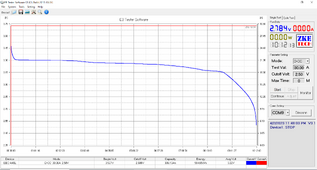RCinFLA
Solar Wizard
- Joined
- Jun 21, 2020
- Messages
- 3,565
Amount of LFP in cathode and graphite in anode determines cell capacity. High discharge current cell design has thinner electrodes with more layers in the wrap to make up the capacity. Each layer has associated copper and aluminum foil so you are adding some material that takes up space for high current designed cells.
Weighting same model cells is a good comparison although resolution on weight to cell capacity is not great. About 70-80% of cell weight is graphite and LFP which is the meat for making capacity.
Thick electrodes yield the most AH's for given volume for cell, but the downside compromise is lower peak cell current capability.
High peak current designed cells have thin electrodes. They also have lower overpotential voltage for given cell current (scaled to total electrode surface area of particular cell).
Overpotential voltage is the discharge voltage slump versus current or bump rise during chargng compared to no-load rested voltage. It is energy to drive the lithium-ion migration within cell in response to cell current demanded. It is temp dependent and gets much worse at cold temps which is why lithium-ion batteries generally suck at low temperatures.
A manufacturer can doctor the electrolyte solvent mix to improve low temp performance but everything has its pros and cons. It may make electrolyte more flammable, shorter life span, narrower safe cell voltage range, or some other side effect you may not want.
Weighting same model cells is a good comparison although resolution on weight to cell capacity is not great. About 70-80% of cell weight is graphite and LFP which is the meat for making capacity.
Thick electrodes yield the most AH's for given volume for cell, but the downside compromise is lower peak cell current capability.
High peak current designed cells have thin electrodes. They also have lower overpotential voltage for given cell current (scaled to total electrode surface area of particular cell).
Overpotential voltage is the discharge voltage slump versus current or bump rise during chargng compared to no-load rested voltage. It is energy to drive the lithium-ion migration within cell in response to cell current demanded. It is temp dependent and gets much worse at cold temps which is why lithium-ion batteries generally suck at low temperatures.
A manufacturer can doctor the electrolyte solvent mix to improve low temp performance but everything has its pros and cons. It may make electrolyte more flammable, shorter life span, narrower safe cell voltage range, or some other side effect you may not want.
Last edited:




